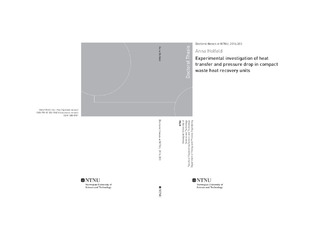| dc.description.abstract | The objective of this thesis is to assess the optimal design of a compact and efficient waste heat recovery.
In order to investigate the heat transfer and pressure drop of compact heat exchangers an experimental rig was build. Eight different finned tube bundles were tested, all in a staggered 30° arrangement. The tube bundles varied in fin type, fin height, fin pitch, fin tip clearance and tube diameter. The Reynolds number was varied in the range between 3500 and 54000, based on the tube outside diameter and the velocity in the minimum free-flow area. The experimental results were compared to literature correlations, showing some agreements but also pointing out a large spread between the prediction results of the correlations. The row-to-row-variation of the heat transfer coefficient was examined as well.
In addition to the experimental data, published data from the literature was collected and used for the development of new correlations for the prediction of heat transfer and pressure drop in finned tube bundles. Therefore a linear regression analysis was carried out. The new correlations predict 95% of the experimental and published heat transfer data within 21% (for serrated-fin tubes) respectively 26% (for solid-fin tubes). The pressure drop data is to 95% predicted within 34%.
The implication for the design of compact and efficient waste heat recover units varies, depending on the main objective. This could be efficiency (small pumping power), small volume and/or low weight. The best fitting design of the waste heat recovery unit needs to be evaluated for each application separately. The results from the experiments and the correlations point towards high fins and a wide tube arrangement for a small pumping power. Small volume waste heat recovery units should tend towards serrated-fin tubes with a large number of low fins and a closely spaced tube bundle arrangement. This is also the case for weight optimised waste heat recovery units. | nb_NO |
